Broadstone, Ayrshire: Difference between revisions
No edit summary |
No edit summary |
||
| Line 31: | Line 31: | ||
In 1603 Hugh Montgomery had accompanied King James I and VI on the journey to London to take possession of the English throne<ref name=j9>Jamieson, Page 9</ref> and his surviving brother George was the Dean of Norwich, becoming one of the court chaplains to King James; (George later became Bishop of Derry). These close contacts enabled him to eventually obtain a one third portion of the lands of Con O'Neill, Lord of the Claneboys, in Ulster.<ref name=j9/> He entertained Con O'Neill at Broadstone and helped him to obtain a pardon for an accusation of 'waging war' against Queen Elizabeth I.<ref name=j9/> Mr James Hamilton, son of the minister of [[Dunlop]], later James Hamilton, 1st Viscount Claneboye, also obtained a one third portion of these O'Neill lands. | In 1603 Hugh Montgomery had accompanied King James I and VI on the journey to London to take possession of the English throne<ref name=j9>Jamieson, Page 9</ref> and his surviving brother George was the Dean of Norwich, becoming one of the court chaplains to King James; (George later became Bishop of Derry). These close contacts enabled him to eventually obtain a one third portion of the lands of Con O'Neill, Lord of the Claneboys, in Ulster.<ref name=j9/> He entertained Con O'Neill at Broadstone and helped him to obtain a pardon for an accusation of 'waging war' against Queen Elizabeth I.<ref name=j9/> Mr James Hamilton, son of the minister of [[Dunlop]], later James Hamilton, 1st Viscount Claneboye, also obtained a one third portion of these O'Neill lands. | ||
Hugh Montgomery brought a colony of Irish Protestants over from his Irish estates in 1600 and later a colony of Protestants from the area were taken over to the Ardes and Clandebora areas of Ulster following the putting down of an Irish revolt.<ref name=r281>Robertson, Page 281.</ref> Hugh was knighted in by King James in 1605, giving him precedency over his rival James Hamilton,<ref>The New Statistical Account]</ref> and he was created Viscount Montgomery of the Great Ardes on May 3, 1622; he died on May 25, 1636 aged 76. The Earl of Mount Alexander was his grandson, his title deriving from his descent from the family of Alexander, Earls of Stirling.<ref name= | Hugh Montgomery brought a colony of Irish Protestants over from his Irish estates in 1600 and later a colony of Protestants from the area were taken over to the Ardes and Clandebora areas of Ulster following the putting down of an Irish revolt.<ref name=r281>Robertson, Page 281.</ref> Hugh was knighted in by King James in 1605, giving him precedency over his rival James Hamilton,<ref>The New Statistical Account]</ref> and he was created Viscount Montgomery of the Great Ardes on May 3, 1622; he died on May 25, 1636 aged 76. The Earl of Mount Alexander was his grandson, his title deriving from his descent from the family of Alexander, Earls of Stirling.<ref name=j10/> | ||
Hugh Montgomery, 1st Viscount Montgomery (1560–1636), is known as one of the "founding fathers" of the Ulster-Scots along with James Hamilton, 1st Viscount Claneboye. Paterson,<ref>Paterson, Page 48.</ref> the historian, records that the 'Laird of Braidstane's Scotch Colony', established in around 1606, was responsible for the introduction of linen weaving and manufacture to the area around [[Lurgan]]; he also built mills, the harbour of [[Donaghadee]], and repaired Port Montgomery (now Port Patrick).<ref name= | Hugh Montgomery, 1st Viscount Montgomery (1560–1636), is known as one of the "founding fathers" of the Ulster-Scots along with James Hamilton, 1st Viscount Claneboye. Paterson,<ref>Paterson, Page 48.</ref> the historian, records that the 'Laird of Braidstane's Scotch Colony', established in around 1606, was responsible for the introduction of linen weaving and manufacture to the area around [[Lurgan]]; he also built mills, the harbour of [[Donaghadee]], and repaired Port Montgomery (now Port Patrick).<ref name=j10>Jamieson, Page 10</ref> Some of the family of Hugh Hammil of the nearby lands of Roughwood accompanied Hugh Montgomerie to Ireland and became established there as merchants in the [[Dublin]] area.<ref>Robertson, Page 373.</ref> | ||
===The Shaws=== | ===The Shaws=== | ||
| Line 40: | Line 40: | ||
The lands of Neubottle, now called Windyhouse, comprised Over and Nether Windyhouse and were feued by Sir John Shaw in 1674 to Thomas Shedden. The lands stayed with the Sheddens until James Shedden, who had two sons, one of whom, John joined the army and died in 1821, whilst the other, Thomas, emigrated to Canada.<ref>Dobie, Page 345</ref> | The lands of Neubottle, now called Windyhouse, comprised Over and Nether Windyhouse and were feued by Sir John Shaw in 1674 to Thomas Shedden. The lands stayed with the Sheddens until James Shedden, who had two sons, one of whom, John joined the army and died in 1821, whilst the other, Thomas, emigrated to Canada.<ref>Dobie, Page 345</ref> | ||
==The Barrs== | ===The Barrs=== | ||
Robertson records a Mary Barr of Broadstone, daughter of J. Barr, who married Robert Buntine-Barr of Trearne and had a son Robert who died at sea.<ref>Robertson, Page 155</ref> | Robertson records a Mary Barr of Broadstone, daughter of J. Barr, who married Robert Buntine-Barr of Trearne and had a son Robert who died at sea.<ref>Robertson, Page 155</ref> | ||
===The Stewarts=== | ===The Stewarts=== | ||
In 1827 & 1829 Broadstone Hall was the residence of Sir M. S. Stewart.<ref>Aitken</ref><ref name=r35>Reilly, Page 35</ref> In 1842 Sir Michael Shaw Stewart, Baronet, retained the farm, together with the superiority of the whole.<ref>Reilly, Page 55</ref> | In 1827 & 1829 Broadstone Hall was the residence of Sir M. S. Stewart.<ref>Aitken</ref><ref name=r35>Reilly, Page 35</ref> In 1842 Sir Michael Shaw Stewart, Baronet, retained the farm, together with the superiority of the whole.<ref>Reilly, Page 55</ref> | ||
===The Browns=== | ===The Browns=== | ||
| Line 56: | Line 54: | ||
Marshalland, Craig and [[Geilsland House|Geilsland]] houses lie across the nearby Powgree Burn, together with the Spier's Old School Grounds, now a public parkland. | Marshalland, Craig and [[Geilsland House|Geilsland]] houses lie across the nearby Powgree Burn, together with the Spier's Old School Grounds, now a public parkland. | ||
==Bogston House and estate== | ==Bogston House and estate== | ||
Bogston House was a residence of the Montgomerie family and it stood between South Barr, Hayhills and Bogfaulds Farms in what is now DM Beith. Bogston was once a well wooded estate of 100 acres, with fine plantings, orchards and gardens. Part of the Giffen Barony, this property was feued out by the Earl of Eglinton to Robert Montgomerie in 1663. In its latter days Bogston was a farm, but following the creation of the munitions storage facility Bogston was demolished and is now only indicated by a small group of trees. | |||
==Quarrying, lime kilns and railways== | ==Quarrying, lime kilns and railways== | ||
Latest revision as of 22:43, 6 April 2017
| Broadstone Castle | |
| Ayrshire | |
|---|---|
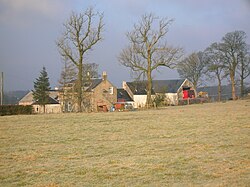 Broadstone Hall near the site of the old castle | |
| Location | |
| Grid reference: | NS355529 |
| Location: | 55°44’31"N, 4°37’17"W |
| Data | |
| Local Government | |
| Council: | North Ayrshire |
Broadstone is a hamlet which sits just south of the small village of Gateside in Ayrshire, and about half a mile east of Beith.
The main feature of the hamlet is the bare mound and its earthworks of Broadstone Castle. The remains of the castle were removed around 1850, when Broadstonehall Farm buildings were being rebuilt, the castle was pulled down and its stones used in the building works; the Broadstone Crags, the site of the castle, remain however despite local quarrying. An avenue of trees and the vestiges of a garden had survived until the time of the building of the farm.[1]
History
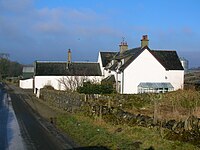
The Barony mill
The Barony of Broadstone, as with most such baronies, had a water mill controlled by the laird to which the tenants were thirled or obliged to go to have their grain ground into flour. The name 'Crooked Dam' relates to a small dwelling that once existed near the Powgree Burn and the remains of a mill pond site shows that this building was originally the miller's dwelling and the old barony mill once lay below the site of the crooked dam.
The Montgomerys
The Lordship of Giffen, included the Baronies of Giffen, Trearne, Hessilhead, Broadstone, Roughwood and Ramshead.[2]
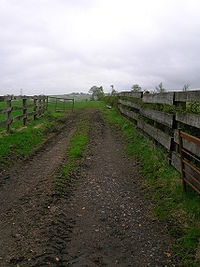
The Barony of Braidstone (sic) was possessed by John de Lyddale (Liddel), Dominus de Bradestane in 1452.[3] Robert Montgomerie of Braidstone was second son of the 3rd Lord Montgomerie. Sir Hugh Montgomerie (1560–1636) was born here in 1560, son of Adam, 5th Laird of Braidstane. He married the daughter of John Montgomery of Hessilhead, and before 1568 he purchased lands from Hugh, third Earl of Eglinton. He left a daughter, Janet, who married Troilus, the second son of Adam Montgomery of Giffen. Andrew Nevin, inherited the Monkredding estate in 1581 and married Janet, daughter of Adam Montgomery, IV laird of Broadstone Castle. Matthew Montgomerie was a resident at Broadstone, but was recorded as living at Bogstone in 1622.[4]
Hugh, first Viscount of the Great-Ardes, granted a mortgage on the lands of Broadstone to his brother-in-law, Sir John Shaw of Greenock in 1650.[5]
The Ulster connection
In 1603 Hugh Montgomery had accompanied King James I and VI on the journey to London to take possession of the English throne[6] and his surviving brother George was the Dean of Norwich, becoming one of the court chaplains to King James; (George later became Bishop of Derry). These close contacts enabled him to eventually obtain a one third portion of the lands of Con O'Neill, Lord of the Claneboys, in Ulster.[6] He entertained Con O'Neill at Broadstone and helped him to obtain a pardon for an accusation of 'waging war' against Queen Elizabeth I.[6] Mr James Hamilton, son of the minister of Dunlop, later James Hamilton, 1st Viscount Claneboye, also obtained a one third portion of these O'Neill lands.
Hugh Montgomery brought a colony of Irish Protestants over from his Irish estates in 1600 and later a colony of Protestants from the area were taken over to the Ardes and Clandebora areas of Ulster following the putting down of an Irish revolt.[7] Hugh was knighted in by King James in 1605, giving him precedency over his rival James Hamilton,[8] and he was created Viscount Montgomery of the Great Ardes on May 3, 1622; he died on May 25, 1636 aged 76. The Earl of Mount Alexander was his grandson, his title deriving from his descent from the family of Alexander, Earls of Stirling.[9]
Hugh Montgomery, 1st Viscount Montgomery (1560–1636), is known as one of the "founding fathers" of the Ulster-Scots along with James Hamilton, 1st Viscount Claneboye. Paterson,[10] the historian, records that the 'Laird of Braidstane's Scotch Colony', established in around 1606, was responsible for the introduction of linen weaving and manufacture to the area around Lurgan; he also built mills, the harbour of Donaghadee, and repaired Port Montgomery (now Port Patrick).[9] Some of the family of Hugh Hammil of the nearby lands of Roughwood accompanied Hugh Montgomerie to Ireland and became established there as merchants in the Dublin area.[11]
The Shaws
After Sir John Shaw in 1650 took a mortgage of Broadstone from his Montgomery brother-in-law,[5] he stayed at the castle occasionally until just after the year 1700. The Shaws gradually alienated the estate in feus until only the farm upon which the castle stood, remained. The family, from Greenock, were resident in 1650 when they purchased the estate.[3] The castle was last occupied in the early 18th century.[3]
The lands of Neubottle, now called Windyhouse, comprised Over and Nether Windyhouse and were feued by Sir John Shaw in 1674 to Thomas Shedden. The lands stayed with the Sheddens until James Shedden, who had two sons, one of whom, John joined the army and died in 1821, whilst the other, Thomas, emigrated to Canada.[12]
The Barrs
Robertson records a Mary Barr of Broadstone, daughter of J. Barr, who married Robert Buntine-Barr of Trearne and had a son Robert who died at sea.[13]
The Stewarts
In 1827 & 1829 Broadstone Hall was the residence of Sir M. S. Stewart.[14][15] In 1842 Sir Michael Shaw Stewart, Baronet, retained the farm, together with the superiority of the whole.[16]
The Browns
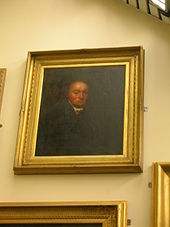
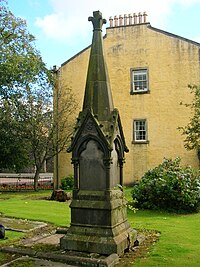
In 1798 Hugh Brown, a merchant in Beith, had purchased Hill of Beith Castle.[17] He had purchased part of the Broadstone lands prior to this, as well as part of the lands of Geilsland, a portion of the lands of Crummock and part of the lands of Lyonshields in the barony of Hessilhead.[17] He built his mansion house at Brae-head House, later known as Crummock Park.[17] His son Hugh inherited in 1809 and another Hugh Brown of Broadstone inherited in 1857.[17]
A memorial at Beith Auld Kirk commemorates the second Hugh Brown of Broadstone (06-04-1787 to 02-01-1857) and his wife Margaret Caldwell (17-08-1783 to 04-06-1845); Hugh Brown Esq is listed as a Justice of the Peace and a member of the Beith gentry in the 1837 Beith Directory.[18]
Marshalland, Craig and Geilsland houses lie across the nearby Powgree Burn, together with the Spier's Old School Grounds, now a public parkland.
Bogston House and estate
Bogston House was a residence of the Montgomerie family and it stood between South Barr, Hayhills and Bogfaulds Farms in what is now DM Beith. Bogston was once a well wooded estate of 100 acres, with fine plantings, orchards and gardens. Part of the Giffen Barony, this property was feued out by the Earl of Eglinton to Robert Montgomerie in 1663. In its latter days Bogston was a farm, but following the creation of the munitions storage facility Bogston was demolished and is now only indicated by a small group of trees.
Quarrying, lime kilns and railways

Several lime kilns formerly operated across northern Ayrshire and the substantial remains of one of the largest of the early stone built kilns is found at Broadstone. It stands right next to the limestone quarry which supplied it. The road running past is still known as 'Reek Road'.
The 'Hillhead Railway' ran to the quarry from Barkip Junction on the Ayrshire and Lanarkshire Railway branch line to Kilbirnie. At first sidings and a transfer system existed with a weighing machine at what was to become Brackenhills railway station, later a direct junction or transfer sidings were laid. The line did not survive into the 20th century and may have been narrow-gauge as indicated by the surviving tunnel / overbridge.
A marble quarry was located nearby, now filled in.[7] The limestone was of such quality that it was worked as marble and was in much demand for chimney pieces.[15]
The old quarry is locally known as Hennis Planting after a worker who died at the site.
Jean Deer

A striking local legend is that of Jane Deer, recoded in a semi-fictional novel of that name by @Tom Service. It tells that Jean Deer's husband worked at Broadstone Quarry in the late 19th century and died there following an accident of an unrecorded nature. She was forced to leave her Broadstone home, with her two young children and her baby, as it was required for another working man and his family. Jean took refuge in a ruinous cottage on the moors near Auchenmade. The winter of 1895 was exceptionally severe and come spring David Muir and Tom Service found Jane dead with two of her children.
Jean's baby however was found alive in the bread oven. Jane, a determined mother was found naked, having fed all her clothes to the fire to keep her baby warm until the last possible moment. She had previously burned all the furniture and the family had so little food that they had even drunk the oil from the lamp.[19]
-
Two very large limekilns in the Hennis Planting near Broadstone Hall farm.
-
The lime kiln wall with Hart's-tongue ferns.
-
Detail of the lime kiln stonework & 'exit'.
-
Looking out from one of the lime kiln's two lower chambers.
-
A view of the lime kiln side wall.
-
Another lime kiln which may predate the quarry beneath.
-
The course of the old 'Hillhead Railway' from Barkip Junction to Broadstone limestone quarry.
-
Overbridge near the old South Windyhouse Farm site.
Outside links
| ("Wikimedia Commons" has material about Gateside, Ayrshire) |
- Commentary and video on Loch Brand - YouTube
- Commentary and video on Hill of Beith Tower - YouTube
- [1] General Roy's Military map of Scotland
- [2] Retting flax
- Broadstone Castle and Mill - YouTube
- Commentary and video on Reek Street, Broadstone Kiln and Jean deer - YouTube
References
- ↑ Paterson, Page 80.
- ↑ Robertson, Page 285.
- ↑ 3.0 3.1 3.2 Coventry, Page 246
- ↑ Paterson, Page 81
- ↑ 5.0 5.1 Campbell, Page 147
- ↑ 6.0 6.1 6.2 Jamieson, Page 9
- ↑ 7.0 7.1 Robertson, Page 281.
- ↑ The New Statistical Account]
- ↑ 9.0 9.1 Jamieson, Page 10
- ↑ Paterson, Page 48.
- ↑ Robertson, Page 373.
- ↑ Dobie, Page 345
- ↑ Robertson, Page 155
- ↑ Aitken
- ↑ 15.0 15.1 Reilly, Page 35
- ↑ Reilly, Page 55
- ↑ 17.0 17.1 17.2 17.3 Dobie, Page 134
- ↑ Pigot's Beith Directory
- ↑ Service, Pages 156 - 157.
- Aitken, Robert (1829). The Parish Atlas of Ayrshire - Cunninghame. Edinburgh : W. Ballantine.
- Campbell, Thorbjørn (2003). Ayrshire. A Historical Guide. Edinburgh : Birlinn. ISBN 1-84158-267-0.
- Catalogue of Abandoned Mines (1931). Mines Department. Vol. V. (Scotland). HMSO.
- Coventry, Martin (2010). Castles of the Clans. Musselburgh : Goblinshead. ISBN 1-899874-36-4.
- Dobie, James D. (ed Dobie, J.S.) (1876). Cunninghame, Topographized by Timothy Pont 1604–1608, with continuations and illustrative notices. Glasgow: John Tweed.
- Gilbert, Thomas & Grace (2010). Windyhouse Farm.
- Jamieson, Sheila (1997). Our Village. Greenhills Women's Rural Institute.
- Paterson, James (1866). History of the Counties of Ayrs and Wigton. Vol. Iv. Cuninghame. Part 1. Edinburgh : James Stillie.
- Paterson, James (1871). Autobiographical Reminiscences. Glasgow : Maurice Ogle & Co.
- Porterfield, S. (1925). Rambles Round Beith. Beith : Pilot Press.
- Reilly, Emilia Georgiana Susanna (1842). A Genealogical History of the family of Montgomery. Privately published.
- Robertson, George (1820). A Topographical Description of Ayrshire: More particularly of Cunninghame, etc. .... Irvine : Cunninghame Press.
- Service, John (1913), The Memorables of Robin Cummell Paisley : Alexander Gardner.
- The New Statistical Account of Scotland. 1845. Vol. 5. Ayr - Bute. Edinburgh : Blackwood & Sons.








